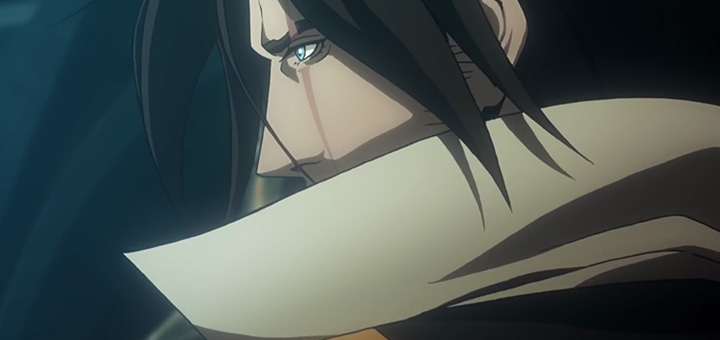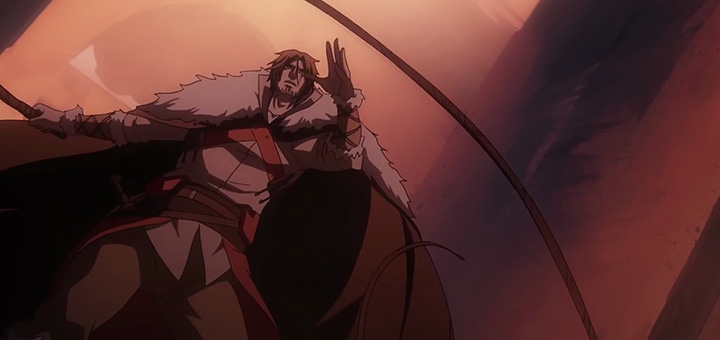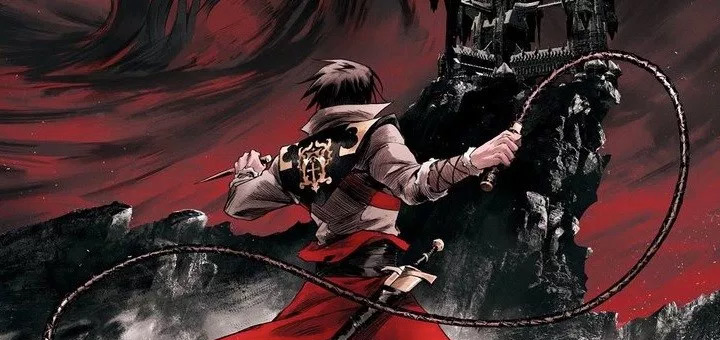A fan’s dream come true
This adaption of Castlevania has been a long time coming. There have been lots of false starts over the years (including a live action feature film), but Warren Ellis’ vision has finally been realised thanks to Netflix. He should be thrilled because the first season of Castlevania is an absolute triumph.
There are two things that you should know before you start watching:
Firstly, this is a fairly faithful adaption of Castlevania 3: Dracula’s Curse instead of the more recent storyline introduced in Lords Of Shadow. Great for fans of the original series of games!
Secondly, this is not a kid’s show. The producer, Adi Shankar, said as much in an interview with IGN prior to release:
[The series is] going to be R-rated as f***.
Without giving too much away – Adi was definitely telling the truth.
Note: This review may contain minor spoilers for the series. If in doubt, watch the series before reading further – go on, it’s only 4 episodes long!

Trevor Belmont has finally made the jump from pixel art to full-scale animation!
The fall of Vlad Tepes
The series takes place in the 15th century and opens with a woman climbing the steps to the castle of Vlad Tepes, otherwise known as Dracula. She turns out to be Lisa, soon-to-be Lisa Tepes and Dracula’s wife. Her ambition and thirst for knowledge in order to help her fellow man encourages him to reevaluate his views of humanity and walk amongst them once again. It adds an interesting dynamic to the show, as it sets up Dracula’s evil ambitions as being driven by very human emotions of love and loss.
Years later, Lisa Tepes is accused of witchcraft due to her scientific knowledge and burned at the stake by the church. This brings the wrath of Dracula down upon Wallachia, as his tenuous link to humanity has been unjustly murdered and he sees to reason to suffer their existence anymore. He gives the people a year to leave, vowing to return a year later and cleanse the lands of any remaining human souls.
The majority of the series takes place a year later when Dracula lives up to his promise and unleashes his demon army across the lands. The audience is introduced to a mysterious vagrant whose life seems to consist of bar brawls and hangovers. This turns out to be Trevor Belmont, a former vampire hunter whose family had been exiled years beforehand by the church. The rest of the series follows Trevor’s journey through Wallachia as he is drawn back into the family business.
Beautiful vistas of Wallachia
The art of Castlevania has always been one of the franchise’s strongest points, so the animation of the Castlevania Netflix series was always going to come under close scrutiny. I’m happy to say that it doesn’t disappoint. Powerhouse Animation Studios has done a great job in conveying the tone and atmosphere of the games into the new television format.
The anime stylings of the show are evident, but Castlevania’s overall style is a lot more subtle than many may expect. The artwork is dark and gothic, with rich use of colour and a good amount of detail packed into every scene. The different characters are well-animated, with facial expressions and body language evident in major and minor characters alike. Conversations are dynamic and characters are constantly engaged and moving around. It definitely feels like a higher-budget production that I had initially anticipated given the project’s troubled development over the years.
The weakest aspect is the fluidity of the movement, particularly during the action scenes. Now, the choreography and direction of these scenes are impeccable, particularly the fight between Trevor and Alucard. However, these scenes do show the limited frames of animation on offer – likely a tradeoff for the detail put into each scene. When compared against some other modern animated movies, some may find this a little off-putting. However, those who grew up on a diet of adult animation like Vampire Hunter D will likely have nothing to worry about.

The action sequences in Castlevania Netflix are fantastic.
Miscellaneous British accents
(Note: I watched the english dub of Castlevania, though I have it on good authority that the Japanese version is fantastic too.)
The voice acting in the Castlevania games ranges from the silly to the sublime. This series leans towards the latter with a voice cast that breathe life into Warren Ellis’ script. Richard Armitage lends Trevor Belmont a wonderfully dry, cynical edge that quickly endears the character to the audience. This flawed version of the character gives plenty of space for a redemption arc over the upcoming season.
I also loved both Graham McTavish’s Dracula and Emily Swallow’s Lisa. McTavish did an excellent job of portraying Dracula through the beginning of the show as a ball of coiled fury and power, held together simply by his affection for Lisa. This was effective specifically because the two actors played so wonderfully well off each other. It makes his fall into rage and madness all the more tragic, to the point where it is hard not to feel sorry for Dracula – not something I expected going into the series!
Finally, the minor characters are all very entertaining and feature a variety of British and European accents. There is one scene in the pub that has to be seen to be believed – let’s just say that Warren Ellis’ original script was basically followed to the letter.
Rondo of blood
The music for the Castlevania Netflix series is a double-edged sword, mostly due to its heritage. If there is one thing that the Castlevania games are known for, it is their amazing soundtracks. The series steers clear of much of this history – outside of a couple of familiar sounding tones, the majority of the soundtrack is atmospheric orchestral music. Anyone expecting to come in and see Trevor slaying vampires to the tune of ‘Bloody Tears’ or ‘Vampire Killer’ is going to be disappointed.
This is not to say that the music in the series is bad – far from it, in fact. The orchestral music is very effective at setting the scene, providing atmosphere during dialogue then swelling appropriately for the action scenes. So the background music is good, but therein lies the issue – it is background music, designed to take a back seat to what is on the screen. Castlevania games are often driven by the music, with stage themes giving areas character and pushing the player forward. In comparison, the music in this series is somewhat forgettable.
Iron Blue Intention
The pacing of the show is quite different to what I expected. Given the game’s content, the marketing buzz about ultra-violence and Adi Shankar’s resume, I was ready for four fast-paced episodes of gory action. Instead we have a thoughtful show with lots of great dialogue, quiet character moments and a surprising amount of humour. Don’t get me wrong – each episode is punctuated by moments of violence which may be shocking for some viewers. The effect of the violence is heightened by the contrast against the more subdued moments of each episode. This restraint is one of the key strengths of the show and demonstrates a level of maturity that is somewhat surprising.
The other nice wrinkle is that the show is not binary when it comes to morality. Dracula’s introduction portrays him as a broken man who, in some twisted way, seems almost justified in the revenge he is seeking to take on the Church. In comparison, the religious leaders who burn Lisa alive are power-hungry killers who enable violence all in the name of the Church. Their purity is tenuous at best – a point well made by a demon moments before killing the Bishop. Dracula’s actions in the show are a reaction to Lisa’s murder, whereas the Church’s motivations are primarily driven by ambition and a lust for power.
This complexity extends to the Belmonts. They were well-known monster hunters but were excommunicated by the church due to their use of magic. Trevor allows his anger at his family’s unjust exile to fuel his self-pity. Until he meets the speakers, he is little more than a self-centred drunk who simply wants to drift from town to town. The point is that morality in Castlevania is murky, with very few truly innocent players to be found.

Dracula is a more complicated character than you may have expected.
Verdict
The vision underpinning Castlevania Netflix is easy to see. This is truely a labour of love, with a beautiful gothic aesthetic and a script that is far more interesting than many probably expected. It certainly isn’t perfect – the animation does suffer from a lack of fluidity and the music doesn’t quite measure up to the legacy of the franchise. The other frustration is how short the first season is. Those four episodes are simply over way too quickly, with the group barely having a chance to come together before the end credits roll.
These are minor gripes in the long run and I expect many of them to be handily eliminated in future seasons. Castlevania Netflix was a joy to watch and is highly recommended, whether you were a fan of the old games or not.
Future
Netflix has already picked up a second season of Castlevania, ordering an additional eight episodes and doubling the expected length of the second season as a result. Hopefully the success of Castlevania Netflix will also open the door for more high quality Netflix-funded video game adaptions.
Finally, I know the reasons why he wasn’t in the series, but Warren. Adi. I’m begging you. Find a way to fit Grant Danasty in!






